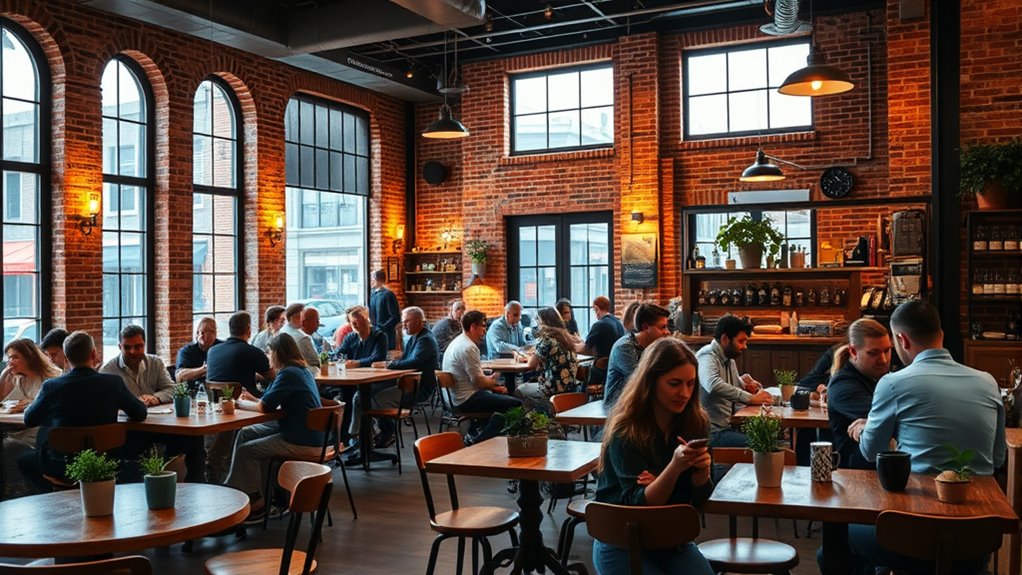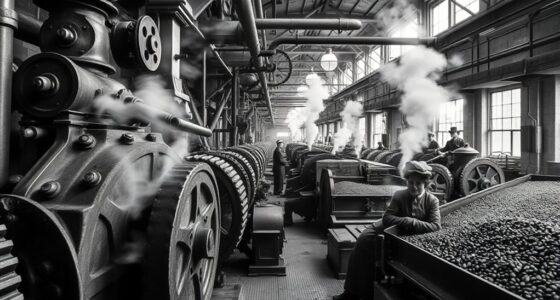Coffee shops have evolved from exclusive spots for the elite into crucial community ‘third places’ where you can connect, relax, and share ideas. They now foster social interaction through welcoming design, local art, events, and inclusivity. These spaces support cultural exchange and community building beyond just serving coffee. As you explore further, you’ll discover how these shops continue transforming into essential hubs that shape social and cultural life in ways you might not expect.
Key Takeaways
- Coffee shops originated as elite gathering spots for intellectuals and traders, fostering debate and idea exchange.
- They expanded into accessible community spaces, encouraging socialization and becoming “third places” outside home and work.
- Design elements like welcoming atmospheres, local art, and event hosting promote a sense of belonging.
- Modern coffee shops emphasize sustainability, inclusivity, and community engagement to reflect social values.
- They now serve as vital social hubs supporting cultural exchange, community connection, and ongoing social transformation.

Have you ever wondered how coffee shops have transformed over the years? Today, they’re more than just places to grab a quick caffeine fix; they’ve become crucial parts of our social fabric. This shift is rooted in the evolution of coffee culture and the emergence of coffee shops as community spaces. Originally, coffee houses served as gathering spots for intellectuals, traders, and social elites. In those early days, they fostered conversation, debate, and exchange of ideas. Over time, as coffee became more accessible, these venues expanded beyond the elite, becoming local hubs for everyday interactions. You might notice how today’s coffee shops often incorporate elements that encourage community engagement—free Wi-Fi, comfortable seating, and collaborative tables—making them inviting spaces for people to connect.
As coffee culture grew, so did the role of these establishments as community spaces. They’re no longer just about the beverage; they’re about creating an environment where people feel welcome and comfortable. Whether you’re stopping by for a quick coffee before work or settling in for a leisurely afternoon, these shops serve as a third place—neither home nor office—where you can relax, work, or socialize. The design and atmosphere are carefully curated to foster a sense of belonging. You’ll notice local art adorning the walls, community boards filled with announcements, and events that bring people together. Coffee shops have become a hub for community-building, offering more than just caffeine—they offer a sense of connection.
Moreover, the contrast ratio of lighting and display screens in modern coffee shops influences the ambiance, making them more inviting and engaging environments. This evolution has also influenced how coffee shops operate; many now prioritize sustainability, local sourcing, and inclusivity, reflecting their broader social responsibilities. You’re part of this ongoing transformation every time you visit, whether you’re engaging with the community or simply savoring your favorite brew. It’s clear that coffee shops have come a long way from their origins, evolving into essential community spaces that nurture social connections and culture.
Frequently Asked Questions
How Have Technological Advances Impacted Coffee Shop Social Spaces?
Technological advances have transformed coffee shop social spaces by boosting digital connectivity, allowing you to stay connected easily. You can now enjoy personalized experiences through apps and Wi-Fi, making your visits more tailored to your preferences. These innovations encourage social interaction, whether through shared online experiences or digital ordering, enhancing the coffee shop’s role as a vibrant third place where you can work, relax, and connect seamlessly.
What Role Do Coffee Shops Play in Community Identity?
You realize coffee shops are the heartbeat of neighborhood gathering, shaping cultural identity in vibrant, unforgettable ways. They serve as the glue that binds communities, offering a space where stories are shared and traditions flourish. By fostering connections and celebrating local flavors, coffee shops become more than just places to sip coffee—they transform into symbols of community pride, making your neighborhood truly unique and alive.
How Do Coffee Shops Influence Local Economies?
You see coffee shops boost local economies by supporting local businesses and creating employment opportunities. When you frequent a coffee shop, you’re helping it thrive, which can lead to more jobs and increased spending in the community. These shops often source products locally, further strengthening the economy. By choosing to visit and support them, you’re actively contributing to the economic vigor of your neighborhood and fostering economic growth.
Are There Cultural Differences in Third Place Coffee Shop Concepts?
Yes, there are cultural differences in third place coffee shop concepts. You’ll notice that cultural nuances shape how coffee shops serve as community hubs, reflecting regional preferences for ambiance, menu choices, and social interactions. In some regions, coffee shops emphasize quiet, individual workspaces, while others foster lively social gatherings. Understanding these cultural nuances helps you appreciate how local traditions influence third place experiences worldwide.
What Future Trends Will Shape Coffee Shops as Third Places?
You’ll likely see coffee shops embracing sustainability initiatives and design innovations to stay ahead. Expect eco-friendly materials, zero-waste practices, and tech-savvy layouts that foster community and comfort. These trends will make your favorite third places more inviting, adaptable, and environmentally conscious. As these elements grow, your visits will feel even more connected to a sustainable, innovative future where community and eco-responsibility go hand in hand.
Conclusion
As you step into a coffee shop today, remember you’re experiencing a space that’s transformed the way we connect, work, and relax. These “third places” have become more crucial than ever, shaping communities and fueling creativity. Just think—your local coffee spot might be the most influential social hub of the 21st century, rivaling even the grandest city squares. So, savor your coffee and embrace the evolving magic of these essential communal havens.









